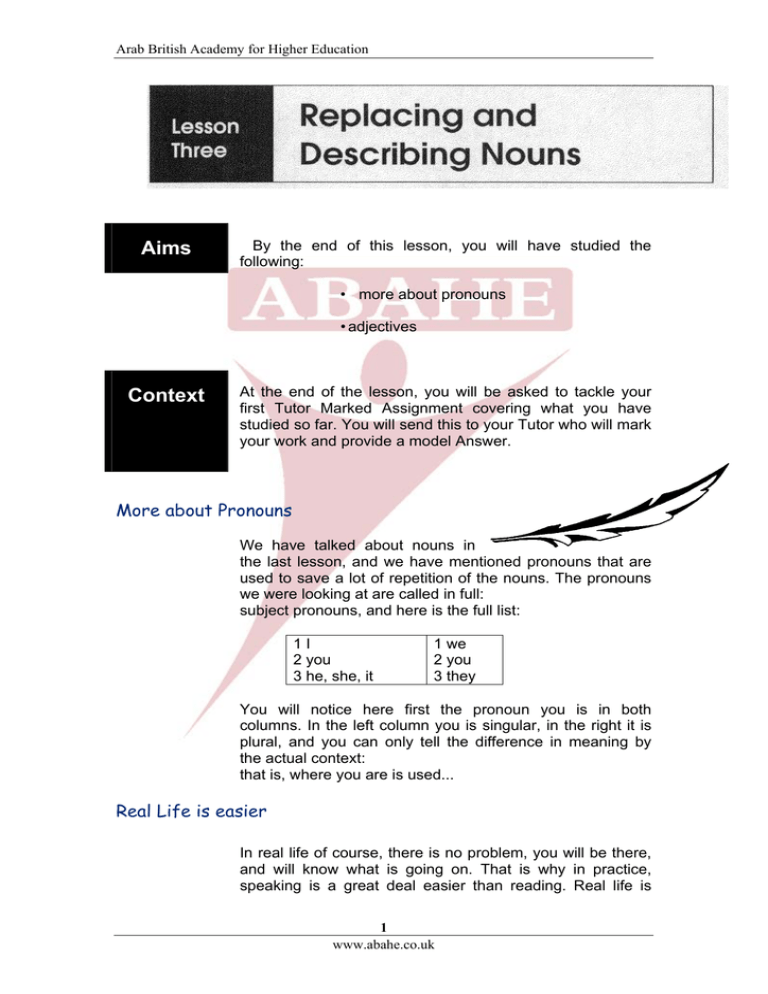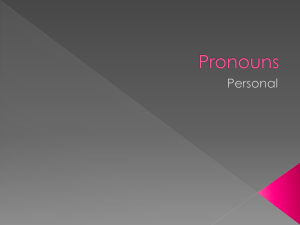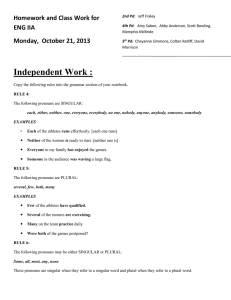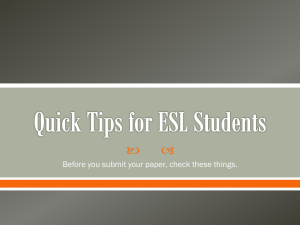
Arab British Academy for Higher Education
Aims
By the end of this lesson, you will have studied the
following:
• more about pronouns
• adjectives
Context
At the end of the lesson, you will be asked to tackle your
first Tutor Marked Assignment covering what you have
studied so far. You will send this to your Tutor who will mark
your work and provide a model Answer.
More about Pronouns
We have talked about nouns in
the last lesson, and we have mentioned pronouns that are
used to save a lot of repetition of the nouns. The pronouns
we were looking at are called in full:
subject pronouns, and here is the full list:
1I
2 you
3 he, she, it
1 we
2 you
3 they
You will notice here first the pronoun you is in both
columns. In the left column you is singular, in the right it is
plural, and you can only tell the difference in meaning by
the actual context:
that is, where you are is used...
Real Life is easier
In real life of course, there is no problem, you will be there,
and will know what is going on. That is why in practice,
speaking is a great deal easier than reading. Real life is
1
www.abahe.co.uk
Arab British Academy for Higher Education
there to help you all the time, whereas on paper you do
often have to rely on your imagination, and of course how
clear is what you see written!
The Three Persons
The next thing to notice is the fact that before each of the
subject pronouns, you have a number: 1, 2, or 3. These are
called as follows:
1st Person Singular = I
1st Person Plural = we
2nd Person Singular = you
2nd Person Plural = you
rd
3
Person Singular = he, 3rd Person Plural = they
she, it
In all languages there are basically three forms of the verb:
I or we 1st Person (often termed number one, as at the end
of the day one’s own self is the most important!)
You (singular and plural) 2nd Person: who you are talking to.
He, she it, they, 3rd Person: everyone else...
Of course the 3rd Person will be used most as otherwise life
would be very limited: you, I, and we being the only topics.
However in conversation the 1st and 2nd Persons are used a
lot as we all like to talk about ourselves!
Aims
There are two main purposes for the given information,
especially if you are unaccustomed to grammar and
grammatical terms.
a)
They will be used for example in comprehension
and composition work as they will enable you to
write and speak with understanding, the only way
to obtain a true knowledge of English.
b)
Some grammar is essential too for anyone
learning a foreign language, as all text books at
some point will refer to grammar. It cannot be
avoided, certainly if you wish to go on to an
advanced study of language, whether English or
another.
Many regard grammar as a bit of an ogre. My view is that if
faced directly it may not be such an ogre, it could even be
friendly.
We are now going
2
www.abahe.co.uk
to
talk
Arab British Academy for Higher Education
about other types of pronouns, having shown you subject
pronouns. The second most important is the object
pronoun, and there are two types: the direct and the
indirect. In the following tables, you have the two kinds.
Direct Object Pronouns
1 me
2 you
3 him, her, it
1 us
2 you
3 them
Indirect Object Pronouns
1 to me
1 to us
2 to you
2 to you
3 to him, to her, 3 to them
to it
Please note the following:
a)
b)
you has many meanings that can only be worked
out from the sentence or situation.
to me, to you, etc, can often be shown as me, you,
while still remaining indirect objects.
See the examples below:
Direct Object
Paul sees me
You can see us
Indirect Object
John speaks to her
We give the books to them
You can also say for the last sentence:
We give them the books where them is an indirect object.
All Rights Reserved © Arab British Academy for Higher Education
3
www.abahe.co.uk








